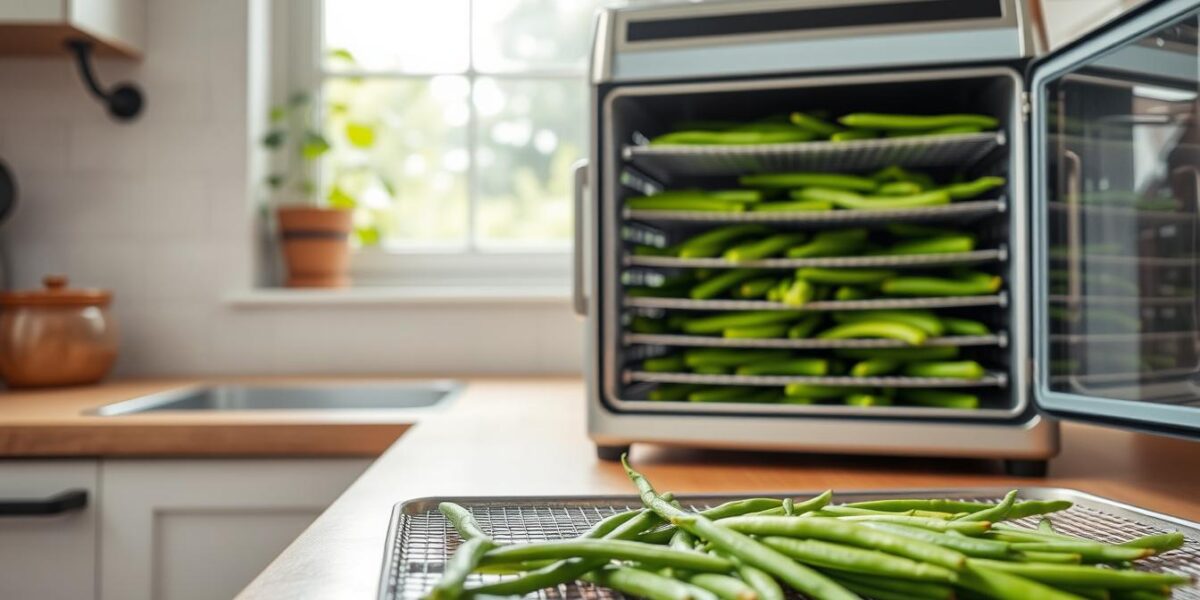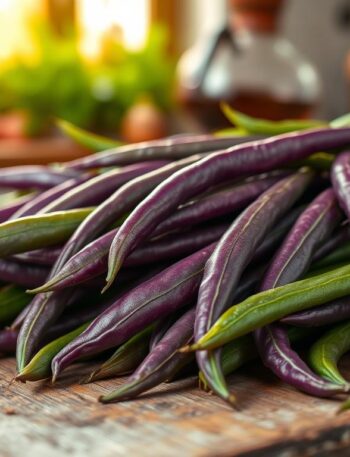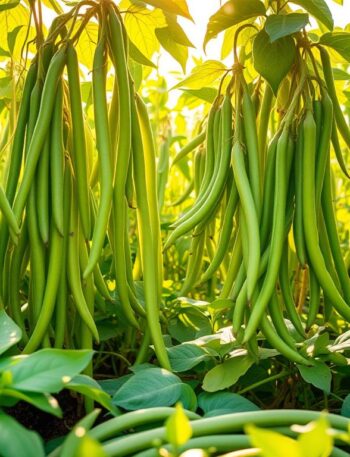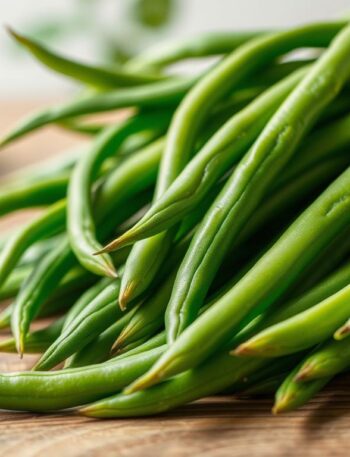Dehydrating green beans is a great way to keep your harvest fresh all year. If you’re new to dehydrating green beans, you’re in the right spot! This guide will teach you how to dehydrate green beans perfectly, so you can enjoy them even when they’re out of season.
We’ll cover everything from picking the best green beans to how to store them. You’ll learn the easy steps to dehydrate green beans and how it makes them taste better and more nutritious. With our help, preserving green beans will be easy and fun, keeping your pantry full of healthy, tasty foods.
Let’s explore the world of dehydrating green beans together. We’ll share tips and tricks to get perfect results every time. This guide is for everyone, whether you’re just starting or have lots of experience. It will help you get the most out of your green beans.
Understanding the Benefits of Dehydrating Green Beans
Dehydrating green beans brings many advantages to home cooks. This method makes them available all year and boosts their taste and nutrition. By using the right dehydration techniques, we can enjoy fresh green beans anytime.
Long-lasting Preservation
Dehydrating green beans is great for keeping them fresh for a long time. By removing moisture, we stop bacteria and mold from growing. This way, we can store them safely for months or even years.
This simple step helps us avoid wasting food. It keeps our pantry full of a healthy vegetable choice.
Enhances Flavor and Nutritional Value
Dehydration also makes green beans taste better and more nutritious. The drying process concentrates their nutrients, making them a rich source of vitamins and minerals. Their flavor gets stronger, adding a delicious twist to our meals.
With each bite, we get a boost of nutrients. This is perfect for snacking or adding to our favorite dishes.
How to Choose the Best Green Beans for Dehydrating
When picking green beans for dehydrating, quality is essential. We seek out vibrant, firm beans for a tasty and healthy snack. Look for signs of freshness to ensure the best quality.
Freshness Indicators
To pick the best beans, watch for these freshness signs:
- Crispness: Fresh beans should snap easily when bent.
- Color: Bright green is a good sign; yellowing means they’re older.
- Texture: They should be firm, without soft spots.
- Absence of blemishes: Steer clear of beans with dark spots or wilting.
Varieties of Green Beans
Choosing the right variety is important for dehydrating. Here are some top picks:
| Variety | Description |
|---|---|
| Blue Lake | Tender and flavorful; great for freezing and drying. |
| French Fillet | Slim, tender, and often used in gourmet dishes. |
| Kentucky Wonder | A classic variety known for its robust flavor and yield. |
Opting for quality varieties will make your dehydrated meals even better.
Preparing Green Beans for Dehydration
Before we start dehydrating green beans, we need to prepare them first. This ensures we get the best taste and nutrients. We wash the beans, trim them, and learn about blanching.
Washing and Trimming
First, wash the green beans under cool water. Rub each bean gently to remove dirt or chemicals. Then, trim the ends to remove tough parts and make them uniform.
Blanching Methods and Its Importance
Blanching is a critical step next. It involves boiling the beans briefly and then cooling them in ice water. This keeps their color and nutrients bright. Blanching also stops enzymes that can spoil the beans.
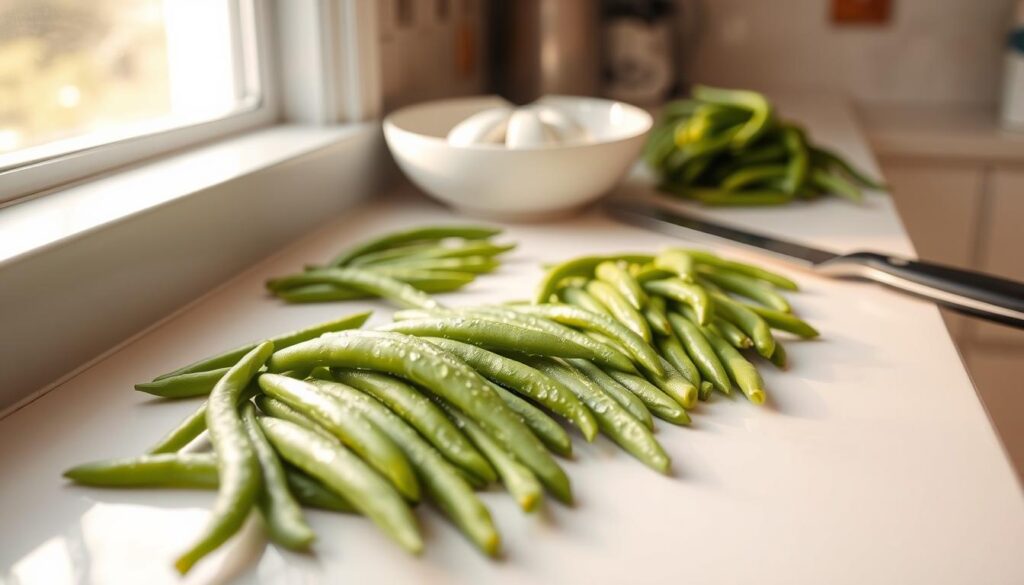
Washing, trimming, and blanching are key to dehydrating green beans well. They make the beans delicious and last longer.
How to Dehydrate Green Beans: Step-by-Step Guide
Ready to learn how to dehydrate green beans? Let’s dive into a simple guide for delicious results.
- Prepare: Start by washing the green beans well. Cut off the ends and blanch them in boiling water for 3 minutes. This keeps their color and nutrients.
- Drying: After blanching, lay the beans flat on your dehydrator trays or a baking sheet. Make sure they’re not stacked to dry evenly.
- Dehydrate: For a dehydrator, set it to 125°F (52°C). Let the beans dry for 6–8 hours. If using the oven, preheat to 140°F (60°C) and check every hour.
- Check for Doneness: After the time is up, the beans should be dry and breakable. Check for any moisture to keep them fresh.
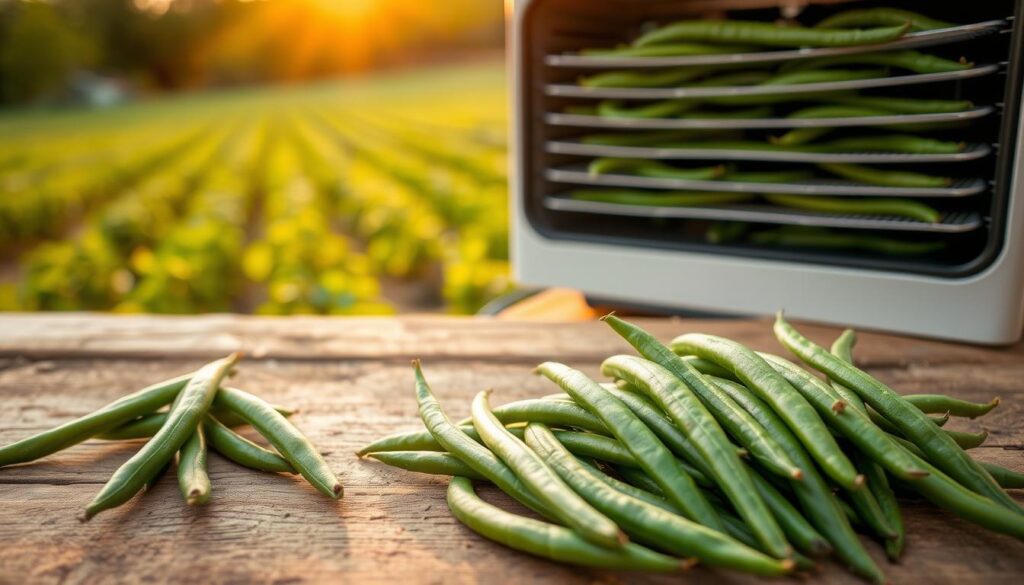
By following this guide, you’ll preserve the green beans’ fresh taste. You’ll also boost your cooking skills. Enjoy making your own dried produce!
Choosing the Right Dehydration Method
Choosing the right method to dehydrate green beans is key. We have two main options: using a dehydrator or oven drying. Let’s look at each to see which fits your kitchen best.
Using a Food Dehydrator
A food dehydrator is the top choice for drying green beans. It circulates air evenly, ensuring all beans dry the same. Set it to 130°F (54°C) and let the beans dry for hours. This method keeps the flavor and texture great, making it a hit with home cooks.
Oven Drying Techniques
If you don’t have a dehydrator, oven drying is a good backup. Here’s how to do it right:
- Preheat your oven to 130°F (54°C) or the lowest setting.
- Spread green beans on a baking sheet lined with parchment paper.
- Make sure to leave space between the beans for air to circulate.
- Turn the beans every hour to dry them evenly.
Both methods can make delicious, dried green beans. Choose what works best for you!
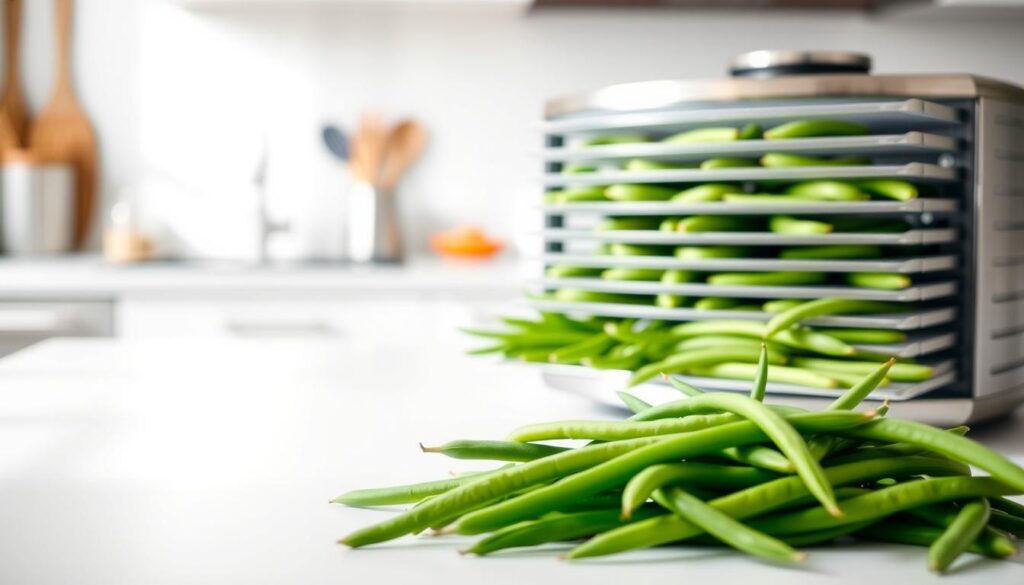
Storing Your Homemade Dried Green Beans
Storing dried green beans right is key to keeping them tasty and healthy. We aim to keep them fresh and full of flavor. The right containers and a few easy tips can make them last longer.
Best Containers for Storage
Choosing the right containers is vital for storing dried green beans. Glass jars, vacuum-sealed bags, and airtight containers are top picks. They block moisture and keep the beans’ flavor bright. Here’s a quick look at different containers:
| Container Type | Advantages | Disadvantages |
|---|---|---|
| Glass Jars | Reusable, airtight seal, non-toxic | Heavy, breakable |
| Vacuum-Sealed Bags | Space-efficient, good for long-term storage | Single-use, requires a vacuum sealer |
| Airtight Containers | Variety of sizes, durable, easy to stack | Can be expensive |
Tips on Shelf Life and Labeling
For the best taste, try to eat your dried green beans within 6-12 months. Keep them in a cool, dark spot to preserve their quality. Labeling them with the storage date is a smart move. It helps you know when they’re at their freshest. Even if they can last longer, older beans might not taste as good.
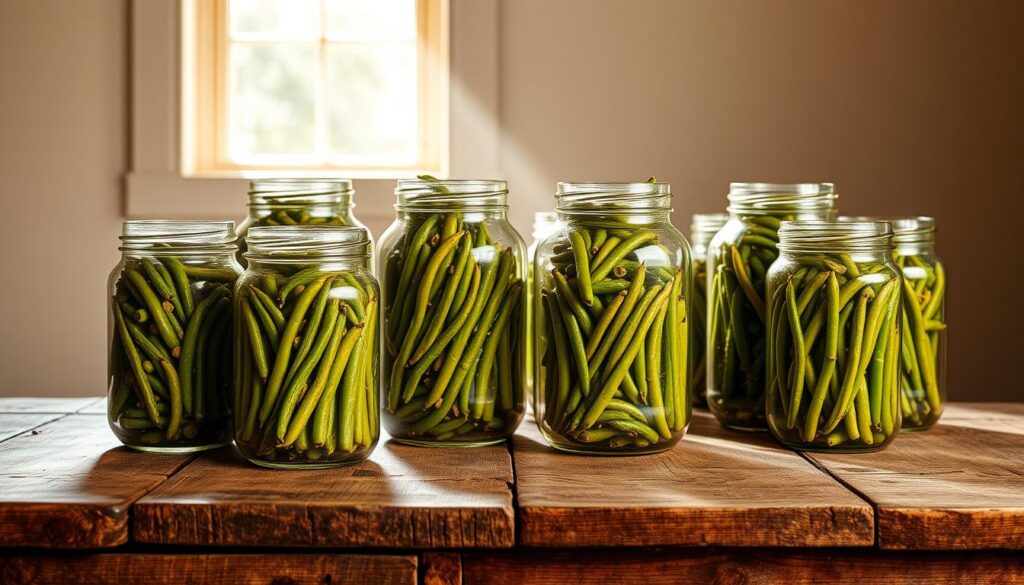
Incorporating Dried Green Beans into Your Meals
Adding dried green beans to your meals can be exciting. They become a great source of nutrition and flavor. First, you need to rehydrate them to use in your favorite dishes.
Rehydrating Dried Green Beans
Rehydrating dried green beans is simple. Just soak them in cold water for 1-2 hours or boil for 10-15 minutes. This makes them soft and ready for cooking. They add color and nutrients to many meals.
Creative Cooking with Dried Green Beans
Be creative when cooking with dried green beans. Use them in soups or stews for extra nutrition. They can also make casseroles or salads better. Try seasoning them for a tasty snack. Experiment with recipes to find new favorites!
Common Mistakes to Avoid When Dehydrating Vegetables
Dehydrating vegetables, like green beans, can be tricky. Some common mistakes can ruin the taste and quality. Let’s avoid these pitfalls to enjoy our dried veggies at their best.
Over-Drying vs. Under-Drying
Getting the drying time right is key. Over-drying green beans makes them taste like cardboard. Under-drying can lead to mold and bad smells. Check them often to find the perfect crisp texture.
Ignoring Quality Control
Quality matters a lot when drying veggies. Bad beans can ruin the whole batch. Always check your beans before drying and throw away any that are damaged. This extra step makes a big difference in taste and safety.
Dehydrator Recipes Featuring Green Beans
Let’s get creative with dried green beans! These dehydrator recipes with green beans bring out their vibrant flavors. They provide tasty and healthy snacks. From spiced green bean snacks to a comforting green bean casserole mix, we have something for every palate.
Spiced Green Bean Snacks
To prepare spiced green bean snacks, start by tossing dried green beans with olive oil. Add your favorite spices, such as garlic powder, paprika, or chili pepper. The combination of flavors will elevate these crispy treats.
Once seasoned, dehydrate them until they reach your desired crunchiness. Enjoy these as a guilt-free snack that satisfies your cravings!
Green Bean Casserole Mix
For a delicious green bean casserole mix, blend dried green beans with cream of mushroom soup mix and crispy fried onions. This dish is convenient and comforting. Simply add water to prepare, and you will have a warm, satisfying meal ready in no time.
For more tips and a detailed guide on dehydrating green beans, check out this helpful resource: dehydrating recipes with green beans. Explore and enjoy the endless culinary possibilities they offer!
Health Benefits of Dehydrated Green Beans
Dehydrated green beans are packed with benefits for our health. They are full of nutrients from green beans. These snacks help us feel full and support our overall health.
Rich in Nutrients
Dehydrated green beans are known for keeping their nutrients. They have vitamins A, C, and K, and dietary fiber. These help our immune system and digestion. Adding them to our meals boosts our nutrient intake easily.
Low-Calorie Snack Option
Looking for healthy snacks? Dehydrated green beans are a great choice. They offer a tasty crunch without the extra calories. Enjoying them makes snacking guilt-free and supports mindful eating.
Conclusion
Dehydrating green beans is fun and a great way to keep them fresh. It brings out their flavors. We can turn fresh green beans into tasty snacks that last long.
This guide showed us how easy it is to prepare and dehydrate green beans. They’re great in many dishes. This makes them a wonderful addition to our food.
Now, let’s start using dehydrated green beans in our cooking. They’re healthy and delicious. Let’s enjoy them all year round. Happy dehydrating!

